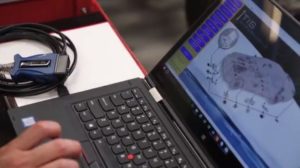
Toyota video shows shops basics of using OEM Techstream Lite scanner
By onEducation | Repair Operations | Technology
Collision repairers who would like to stick purely with OEM scanning devices should check out a new training video by Toyota explaining just how and why to run a scan with the Toyota “Techstream Lite” system.
“Not all diagnostic trouble codes trigger a malfunction indicator light,” Toyota Collision Repair and Refinish Training assistant manager Eric Mendoza declares in the April film, available for free on the CRRT website. “… Therefore, if you rely solely on the dashboard to determine the scope of your repairs, then there could be concerns within your customer’s vehicle that you fail to address.”
Mendoza then demonstrates the Techstream Lite, Toyota’s term for a combination of any laptop that meets Toyota requirements, a MongoosePro MFC2 Interface cord from Drew Technologies and Toyota diagnostics software.
In the film, Mendoza hooks up the laptop with the cord and checks electronic control units for health codes through what appears to be a relatively straightforward procedure.
“Performing a health check is quick and easy and helps to ensure that you return your customer’s vehicle with all concerns addressed,” Mendoza concludes.
The video is a good resource and might help less tech-savvy auto body professionals feel less daunted by the idea of “scanning” a vehicle with an OEM equipment suite rather than an aftermarket technique.
Of course, there’s still the rest of the diagnostics process, in which a repairer determines how to fix everything indicated by those trouble codes. There’s likely also to be calibration of systems disrupted by the collision and subsequent repair process.
But not to worry — Toyota has participated in at least two other videos that might help a shop understand at least the calibration concept.
One produced by Auto Body Repair Network in 2015 and posted on the CRRT site features Mendoza and then-Lexus technicial and collision repair trainers manager Bill Zlaket. In it, the trainers discuss advanced driver assistance systems and why they need to be calibrated.
Mendoza was kind enough to participate in another video with us in 2016, this time regarding checking and calibrating the passenger seat Occupant Classification System.
This technology is essentially a smart scale that determines whether it’s safe to blow a front passenger airbag or if the passenger is so small – i.e., a child – that there’s a higher risk of injury in a crash with an airbag deployed than without one.
And if all of that Toyota-generated knowledge wasn’t enough, a collision repairer can always review the recent SCRS and Collision Hub videos breaking down diagnostics and calibration concepts.
More information:
“Importance of sensor recalibration”
Auto Body Repair Network YouTube channel via Toyota Collision Repair and Refinish Training website, Sept. 28, 2015
“How to Perform a Health Check”
Toyota CRRT YouTube channel via CRRT website, April 18, 2017
Collision Hub May 2017 “Repair University LIVE” feed
Collision Hub Livestream page, May 24, 2017
“SCRS Education Committee Presents – Scanning, Diagnostics and Calibration”
Society of Collision Repair Specialists YouTube channel, April 18, 2017
Toyota Collision Repair and Refinish Training video page
Toyota Collision Repair and Refinish Training website
Featured image: Toyota Collision Repair and Refinish Training assistant manager Eric Mendoza demonstrates the Techstream Lite in this screenshot from a Toyota CRRT training film. (Screenshot from CRRT video)
